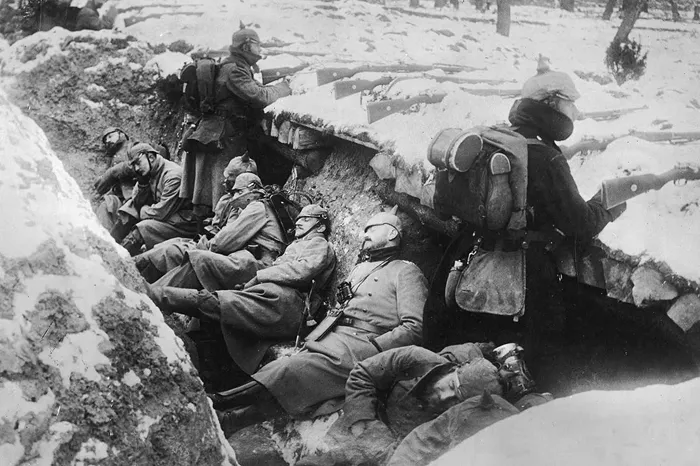Life in the trenches during World War I was a harsh, brutal experience that exposed soldiers to the full horrors of warfare. Trenches became the defining feature of the Western Front, where millions of soldiers lived in dire conditions for extended periods. This article explores five crucial aspects of life in the trenches, shedding light on the physical, psychological, and emotional toll endured by soldiers who fought in one of the deadliest conflicts in history.
What Was Life Like In The Trenches?
World War I, which raged from 1914 to 1918, introduced a form of warfare unlike anything seen before. The advent of machine guns, tanks, poison gas, and advanced artillery led to devastating casualties. As opposing armies dug in, trench warfare became the norm, especially on the Western Front, where British, French, and German forces engaged in protracted battles. The trenches themselves were not just a defensive necessity but a symbol of the grim reality that soldiers faced. For much of the war, soldiers lived in these trenches, exposed to the elements, disease, and the constant threat of death. The conditions in the trenches were both physically and psychologically punishing, making it clear that the cost of war extended far beyond the battlefield.
1. The Physical Environment of the Trenches
The trenches were typically narrow, cramped, and filthy. Soldiers spent days, weeks, or even months in these underground networks, often with little opportunity to leave. The trench system was designed to provide protection from enemy fire, but the living conditions were far from ideal. Trenches were often filled with mud, especially during the rainy season. The floors became slick with water, and soldiers frequently had to stand in several inches of stagnant water or worse, which led to diseases such as trench foot.
The walls of the trenches were lined with sandbags or wooden supports, but these provided little protection against artillery shells, which regularly caused explosions and ruptures. The cold, damp environment, combined with the filth, made life in the trenches unbearable for many soldiers. Personal hygiene was virtually impossible, leading to a rapid spread of lice, rats, and other vermin.
2. The Constant Threat of Death and Injury
The trenches were constantly under fire from the enemy. Soldiers faced the persistent threat of sniper fire, artillery bombardments, and surprise attacks. Life in the trenches was defined by the constant awareness that death could come at any moment. Soldiers rarely felt safe, even within the relatively protective confines of the trench system.
On the frontlines, soldiers would spend days waiting for orders to “go over the top” — the term for charging across No Man’s Land, the desolate area between opposing trenches, where the risk of being shot, blown up, or gassed was high. Casualties were frequent, and many soldiers witnessed their comrades falling in gruesome ways. Medical care was limited, and the wounded faced long waits before they could be treated, if they were fortunate enough to survive.
3. The Psychological Toll of Trench Warfare
The psychological toll of life in the trenches was immense. The constant fear of death, the appalling living conditions, and the loss of comrades took a heavy toll on the mental health of soldiers. Many soldiers suffered from what was known as “shell shock” — now recognized as post-traumatic stress disorder (PTSD). The bombardment of shells and the relentless noise of war caused many men to become mentally and emotionally debilitated.
The monotony of trench life also contributed to psychological strain. Soldiers spent long stretches of time in the trenches with little to do other than wait. This created a sense of isolation and despair, and many soldiers felt disconnected from the world outside. The war became an all-consuming experience, and for some, there was no sense of hope or purpose. Depression, anxiety, and suicidal thoughts were widespread.
4. The Role of Rats and Lice in Daily Life
Rats and lice were an ever-present nuisance for soldiers in the trenches. The rats in particular were notorious for being attracted to the food scraps and human remains in the trenches. These rats grew to enormous sizes, sometimes as big as cats, and would scavenge for food, creating a terrifying atmosphere in the trenches. They also spread diseases such as typhus and other infections.
Lice, another infamous part of trench life, caused constant discomfort. Soldiers would frequently find themselves scratching their bodies raw due to the lice, which thrived in the unsanitary conditions. Lice also spread disease, and their presence contributed to the overall sense of filth and suffering in the trenches.
5. The Limited Access to Food and Clean Water
Food in the trenches was often of poor quality and difficult to come by. Soldiers subsisted on rations that were sometimes stale, poorly cooked, and unappetizing. Typical meals might include tinned meat, bread, and sometimes soup.
Fresh food was a rarity, and soldiers rarely had the opportunity to eat hot meals or anything resembling a balanced diet.
Clean drinking water was also in short supply, and many soldiers had to rely on impure sources. As the trenches became more waterlogged, the risk of contamination from human waste and rotting bodies increased. The scarcity of food and water compounded the misery of trench life, and malnutrition was a constant threat.
Conclusion
Life in the trenches was nothing short of grueling. The physical environment, the constant threat of death, the psychological strain, the infestation of rats and lice, and the limited access to basic necessities made life in the trenches an unimaginable hardship for the soldiers who endured it. Despite the unimaginable suffering, the soldiers demonstrated extraordinary resilience, and their experiences have since become a symbol of the devastating cost of war.
Understanding the conditions of trench warfare helps us appreciate the sacrifices made by those who fought and the toll war takes on those who survive. It is a stark reminder of the price of conflict and the profound impact it leaves on the individuals who experience it firsthand.
Related topics:


